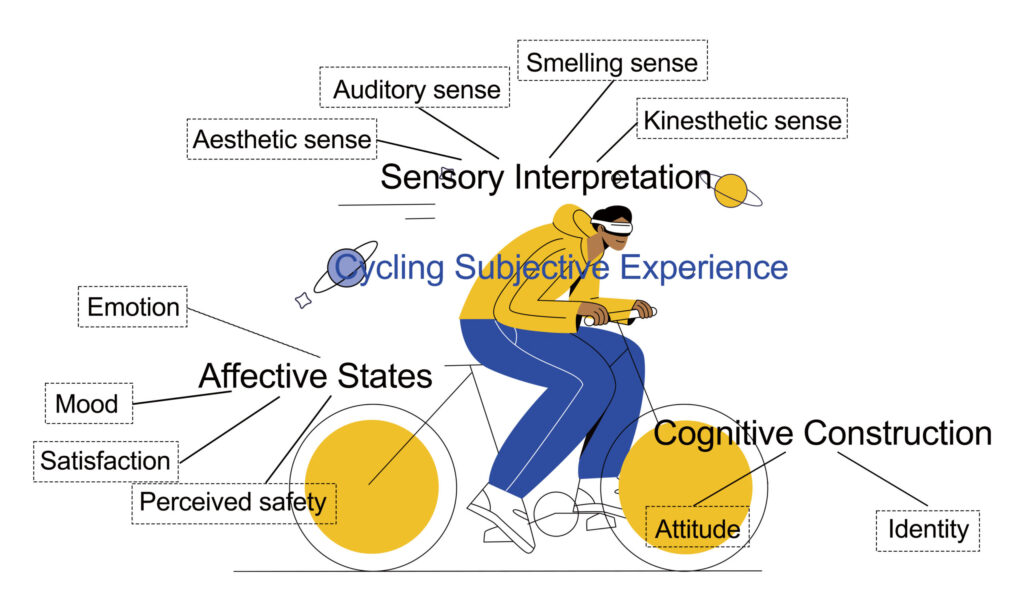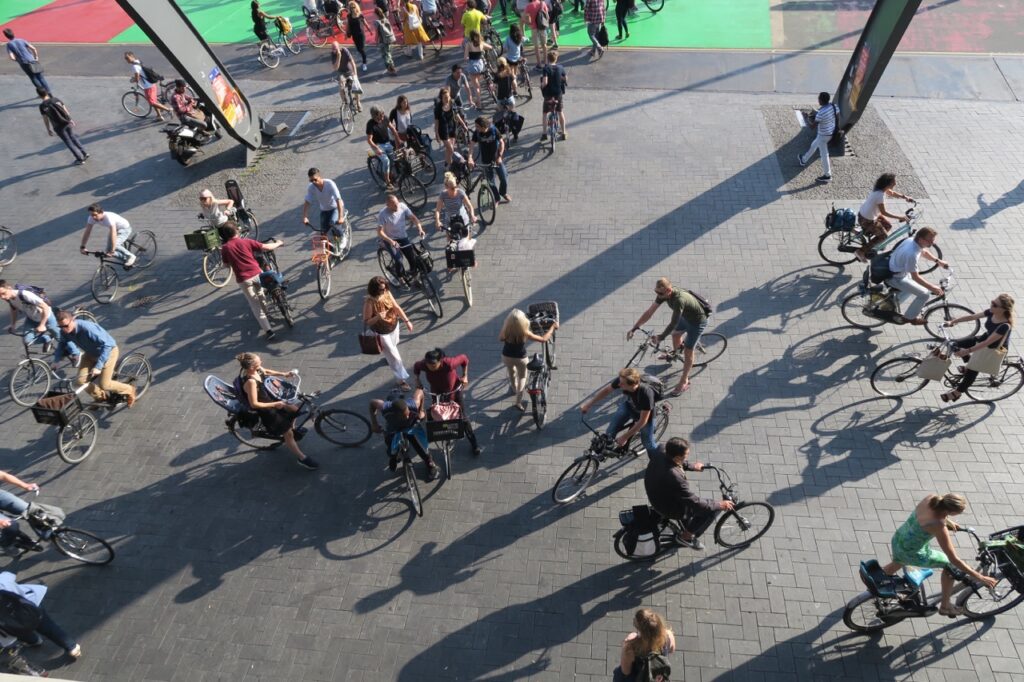Are researchers and policy-makers in the domain of road safety reflecting on the underlying values and worldviews on which these interventions are build? Do we fully grasp the choices that are embedded in those values and on how these then solidify into our guidelines, streetscapes and behaviour? In his recently published research article, Marco te Brömmelstroet argues that those underlying choices are exactly what is holding back real radical change in making our roads and traffic safe. The article discusses seven mechanisms in how road safety is currently studied, discussed and designed that might aggravate the inherent unsafety it aims to reduce. Building on this, the final part of the paper aims to open up the underlying values by proposing seven potential ‘what-ifs’ away from focusing on increasing road safety to instead explicitly focus on reducing the systemic danger. You can read the main parts of the article here.
Language is not a mirror
Literally nobody is against road safety. But ‘the language and information systems of an organization are not an objective means of describing an outside reality—they fundamentally structure the perceptions and actions of its members’ (Kofman, 2018). Hence, the language we use to discuss road safety is not an objective mirror of reality. Instead, it profoundly shaped and shapes our contemporary mobility system, our streets and the ways we have to behave on them. And as such it will continue to shape our future. The concepts we use to approach, talk and think about road safety, the way we define it, and the approaches we use to do research strongly impacts how we define problems and where we look for solutions.
So, although literally nobody is against road safety, we should unpack these concepts. Here, this analysis is conducted first in terms of system performance (Meadows, 2008): how can variables of road safety be measured and what are the intrinsic limitations of our concepts (Elvik, 2008)? Second and third, I aim to unpack our road safety language in terms of system purpose (what do we define as the overall goal?) and system boundary (what are the limits of the overall understanding of what road safety is?). To do this, below I first explain how such language is created and how that influences reality. Then, I discuss the key tenets of traffic engineering to sketch the context in which we think, study and talk about road safety. As a third step, I explore seven problematic mechanisms that are caused by this and end the paper by offering seven potential ‘what-ifs’ to explicitly open up the choices we make and can remake.
In a question often used for IQ testing we see a group of geese under a tree (Figure 1). A first question to ask the reader is: ‘How many geese do you see? Look carefully—can you spot and count them all?’. Once you think that you counted all of them, a next question is: ‘They are all facing life-threatening danger: how can we save the poor birds?’
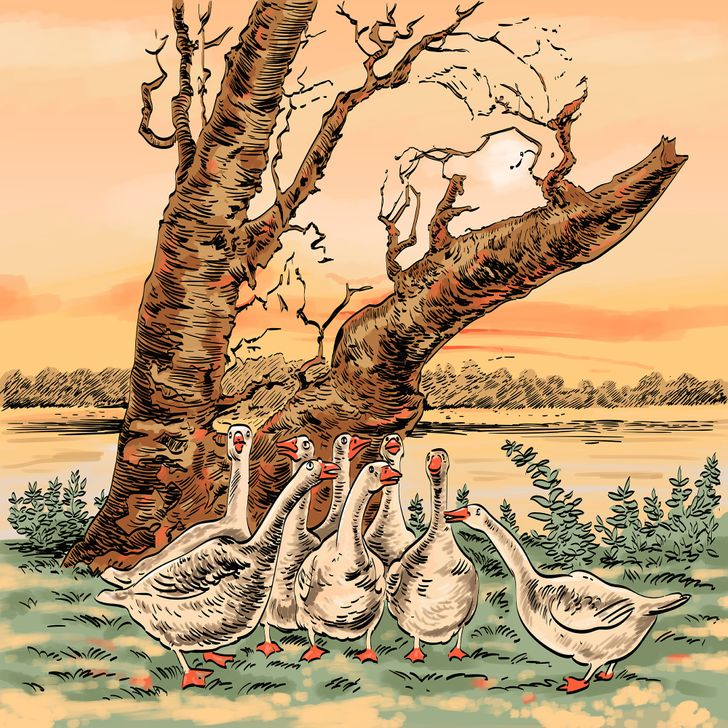
Language is a necessary simplification of reality: individuals and organizations need such simplification to be able to exchange thoughts and communicate with each other. In this process of simplification, choices have to be made (see examples of how this works in relation to metaphors in Lakoff and Johnson (2008), (Morgan, 2006) and (Scott, 1998)). The inherently arbitrary choices that are made in the development of a language become highly performative; they highlight certain characteristics of a complex phenomenon that fit with a narrative while obscuring others. A narrative here is a coherent story that provides consequential links between events or ideas and imposes meaningful patterns on what would otherwise be random and disconnected (Riessman, 1993; Verkade & te Brömmelstroet, 2022). In a narrative, important choices about how to understand a system’s boundary (what variables are in and which are out), a system’s purpose (what is it all for) and a system’s performance (how to measure change) are made (Meadows, 2008).
Different narratives compete in periods of ‘interpretive flexibility’. When one of these narratives starts dominating, we see ‘interpretive closure’. A process of solidification starts in which the choices that are made in understanding a specific domain solidifies and a dominant ‘discourse coalition’ forms: a powerful group of actors that have shared interests and a linguistic basis that is based on an ensemble of ideas, concepts and categories through which meaning is given to ambiguous social circumstances (Hajer, 1993) [p.45].
While at the start, the arbitrary choices that underlie the original narrative remain front and centre and are politicized, over time they are no longer questioned and become taken-for-granted. It becomes a depoliticized ‘radical monopoly’ (Illich, 1974) that is completely taken for granted and no longer questioned.
The discourse then becomes a performative guide for the actions of all relevant mainstream agents—ranging from public administration, industry, the civil sector and academia. These actions, in turn, reinforce the discourse coalition to make experiences coherent fuelling a self-fulfilling prophecy with a strong path-dependency. This is how the discourse becomes increasingly performative.
So, if we accept that this discourse is not a mirror but a lens that frames what we see, how does this language shape the problems and solutions that we, in academic research, in the media and in the public and political debate, see? And, arguably more importantly, how can we shape a different lens that will help us shape a radically different future?
Seven problematic mechanisms within road safety language
- We add up morally incompatible categories
- We confuse citizens with consumers to calculate the toll
- We use cold statistics that dampen a sense of urgency
- We forget to compare
- We speak about accidents instead of systemic properties
- We focus on victims instead of all parties involved
- We teach our children to behave safely and normalize road violence
Is current road safety discourse still useful?
Let’s revisit the question I asked you in the introduction. On the picture (Figure 1) we can spot a group of eight geese. So, how to save all of them from a life-threatening danger? When our attention goes to ‘saving lives’ we tend to focus on instructing the victims and to change their individual behaviour. But then we forget to see and address the actual source of the danger. Most people also fail to spot it in the picture of the geese. If you did; go back and look in the tree. Do you see it? It is not pollution, or global warming. But did you see … the wolf in the tree?
Discourse on road danger opens up choices
Literally nobody is against road safety. But the language we use is not an objective mirror of reality. It is a lens that profoundly shaped and shapes how we define the problem of road safety and which solutions directions we seek. The current road safety discourse makes us complacent in the ongoing and growing carnage in transport systems. A discourse that did not minimize the systemic violent properties of the mobility system. On the contrary, it removed the traffic system itself and the foundations on which it is built from the realm of possible critique. Because when the system itself is the cause, then the only solution is currently unthinkable: for reducing systemic traffic danger we then have to radically change the traffic system itself. And not only the infrastructure, but curbing the dangerous functioning of motorized vehicles.
What if we would really want to work on effective solutions? That requires a shift of system purpose from ‘increasing road safety’ to ‘reducing road danger’ and challenging our system boundary to also bring back elements of justice. The first make it easier to spot the wolf instead of targeting the geese, while the second helps us asking not only if or how a certain intervention might work, but also if the potential outcomes are even desirable. Instead of limiting the discussion to (f)utility of road danger interventions to also include more sensitivity to their potential jeopardy and perversity (Hirschman, 1991).
The way we talk and think about our roads is a choice. Our choice. So, what if we start to challenge the choices that underlie it! What if we stopped talking about Road Safety and instead rename our field by referring to the actual problem we are trying to solve: Road Danger. What if we rename our journals to Journals of Road Danger, together go to annual Reducing Road Danger conferences and present Road Danger Reduction schemes to the responsible politicians. What would happen if instead of talking about increasing safety, we would problematize and reduce the systemic danger itself? In Table 1, I illustrate with 7 ‘what-ifs’ how the seven mechanisms could be questioned to open up the underlying choices in system purpose and system boundary.
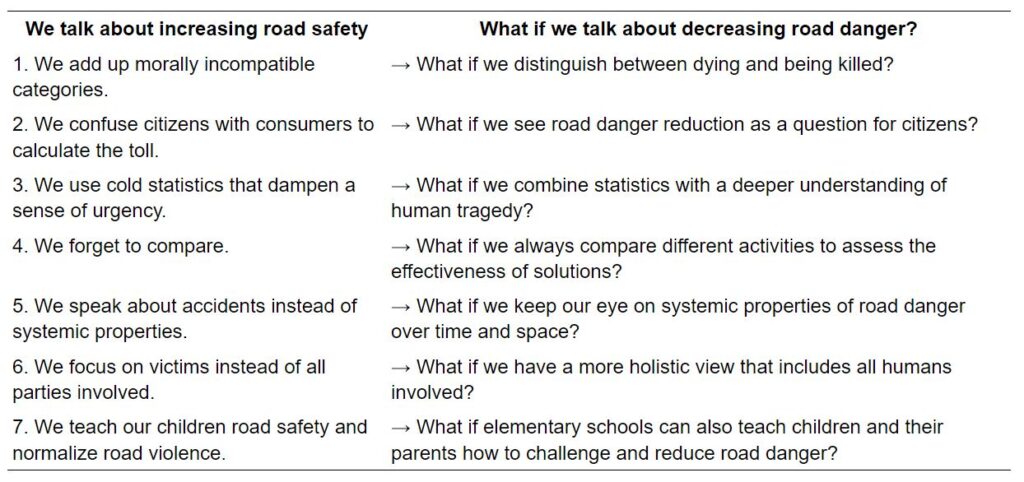
Re-politicizing these choices might reveal more popular support for interventions than we currently find. If we manage to present the reduction of road danger not as taking away privileges from car drivers, but as giving back privileges to so many others (Gössling, 2020). Not lowering speeds, but opening streets. Especially for our children. In many countries (e.g. in Japan, Spain, Wales, the Netherlands), cities are already lowering speed limits across the board. Often making 30 km/h the new norm, but in Barcelona superblocks it is even lowered to 10 km/h (Nello-Deakin, 2022). Mayors that take such seemingly unpopular steps are often re-elected because their popularity rises after the intervention is experienced. And we don’t only have to look at road design and policing either. If we want to take the violence out of the system, we can actually now limit the maximum speed of vehicles. Intelligent Speed Assistance combined with geofencing can give us back control over the acceptable levels of violence in our public spaces, in which society can decide on the accepted maximum speed that than simply cannot be overruled (Hansen et al., 2022).
Next to opening up the choices within the dominant discourse by exploring the seven alternative mechanisms, I close with four direct strategies that we can consider:
Change our educational programs. From the early days of car traffic, parents asked schools to educate their children about the new dangers on the street and how to avoid them. To this day, professional organisations offer elementary schools all kinds of off-the-shelf programs. In the Netherlands, about 50% of all elementary schools have traffic lessons on their curriculum and spend about 1 hour per week on it. The largest package that is used by most is the VVN material addressed above. There is little to no evidence that they work. Each package focuses on disciplining children and normalizing danger. Let’s work instead on developing alternative educational programs that teach our children (and their parents) how the danger on our streets has been constructed and how they can actively work towards improving this situation. Let’s also find ways to fund this that do not include the car and oil industry.
Crash matrixes as the way to represent the problem. Instead of statistics of victims we can present the same data by also showing the other party. In doing this, we should actively denounce the idea that this representations shows blame or liability. Crash matrixes give a visual overview of how different modes are involved in crashes in which people die and get injured and have been used from the start of road safety statistics. More recently they are recently discussed by others (Elvik, 2008), but are not a very central part in our communication in academic, policy and popular circles. Crash matrices have been recently reintroduced in several countries and the EU. The website (Roaddanger.org, n/d) offers an open source citizen-science platform that allows volunteers to develop such crash matrices through categorizing local newspaper reports (Figure 3).
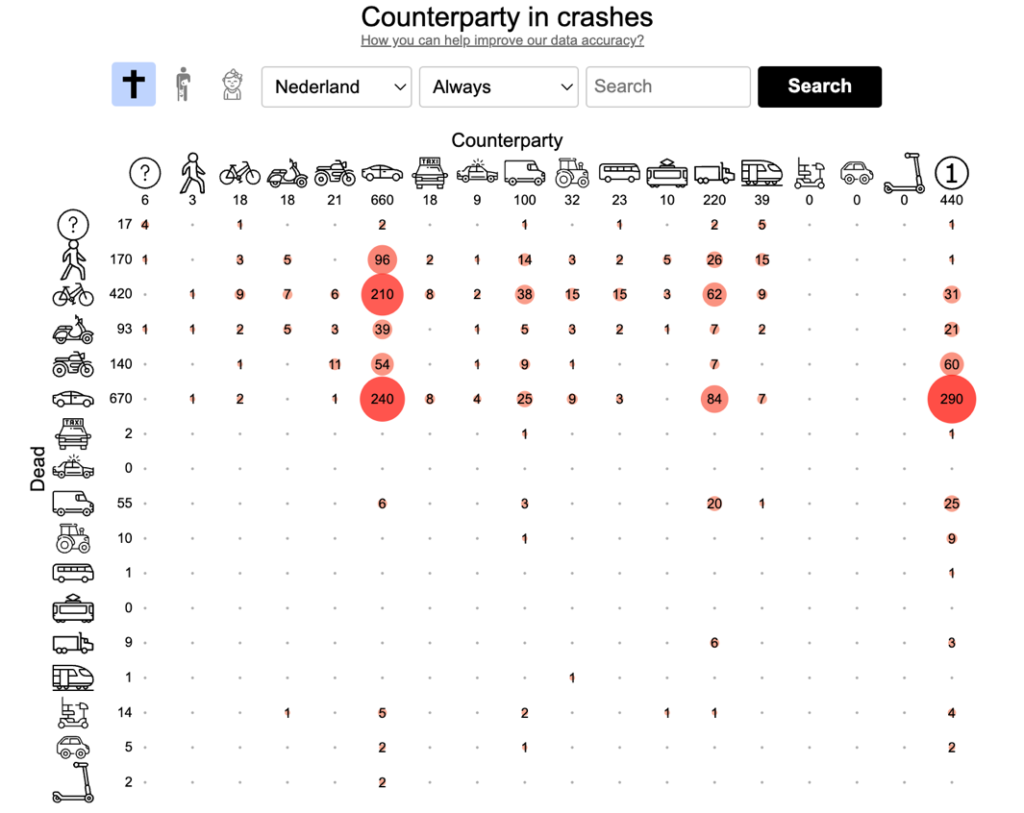
Talk about human tragedies instead of glitches in the machine. We have taken for granted that traffic crashes are presented as a natural occurrence, with statistics and newspaper reports that resemble the daily weather forecast. We need to talk again much more about the human tragedies they involve, as currently is increasingly done in Australian mainstream media. It is only through looking the beast in the mouth that we can hope for transformative change (Virilio & Ruby, 1998). Training journalists to make different editorial choices is a necessary but not sufficient condition for this. We find that the complexity of the violent incidents cannot be captured in good vs. bad linguistic choices (Kwakman et al., 2023). We need to treat every crash as any other violent incident and report on it accordingly. If most radio stations now spend 1 minute per half hour to update us all on congestion, this means that we can start by repurposing these 350 minutes every week to have a more meaningful discussion.
A relentless focus on the systemic nature. Godwin’s law predicts that as an online discussion grows longer, the probability of a comparison to Nazis or Adolf Hitler approaches 1. A similar law could be introduced for how conversations about traffic crashes slip into a blame-game: are all humans involved clearly mentioned? Do we know who ignored traffic rules? Who is victim and who is culprit? Are there other characteristics of those people such as age, occupation or type of bicycle they ride? Are there behavioural clues that can be blamed, such as alcohol, drugs, distraction or tiredness? We need to restrain ourselves. Yes, we should dive deeper into details as part of describing the tragedy. But we should always keep our eye on the ball: it is the system itself that produced landscapes of fear and anxiety (Culver, 2018) [p. 162]. And that produces the sheer violence to which we are all exposed. We should keep a relentless focus on how the intrinsic nature of system violence is a phenomenon that can only be seen across space and time (see Figure 4 as illustration).
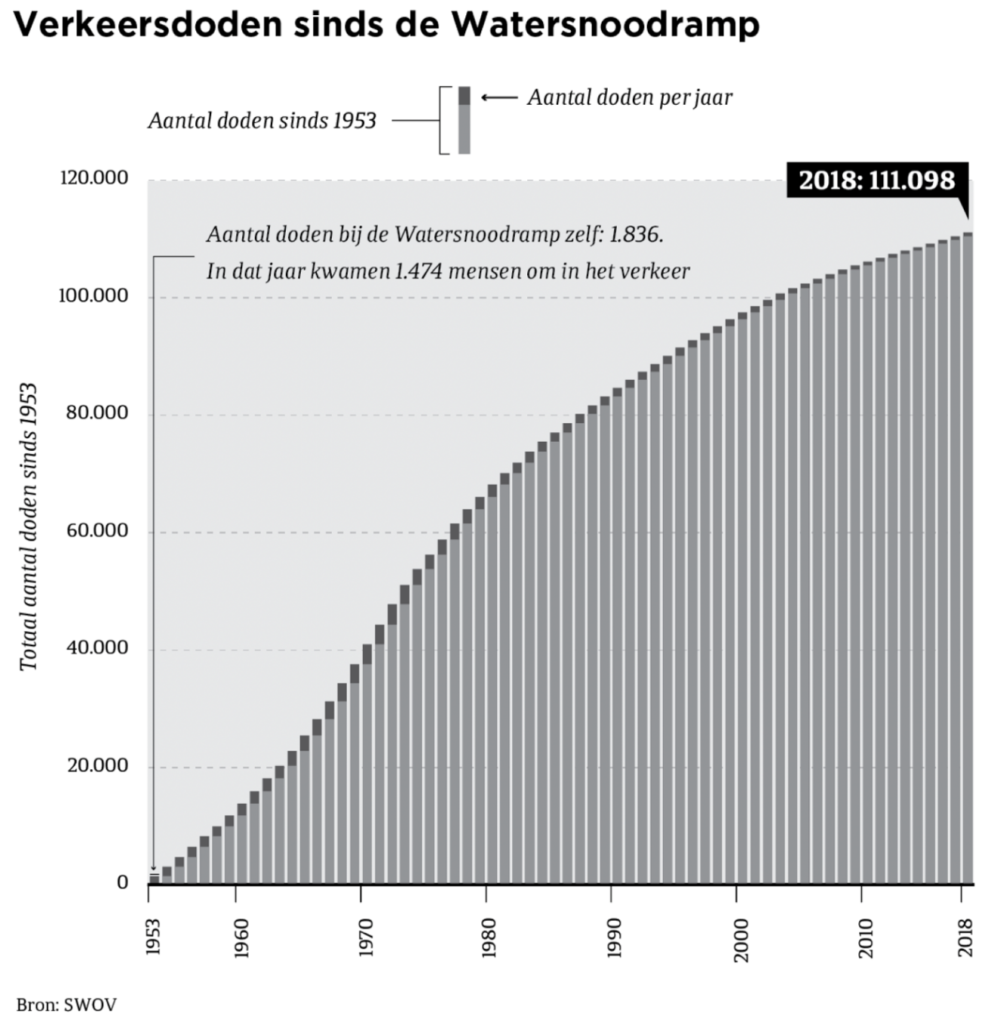
Reference:
te Brömmelstroet, M. (2024). Increase road safety or reduce road danger: challenging the mainstream road safety discourse. Traffic Safety Research, 5, e000043.


